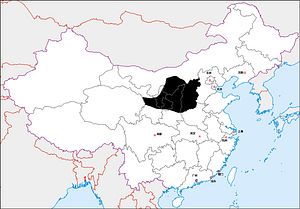This article series explores 12 distinct “regions” within China: six “core” regions long dominated by the majority Han ethnic group and six “periphery” regions home to many of China’s ethnic minorities. The series overview is available here. To view the full series, click here.
The loess plateau is the birthplace of Chinese civilization, a country of windblown “yellow earth” that erodes into the Yellow River and gives the North China plain its fertility. Walled off by the Taihang mountains, the defensibility of this “land within the passes” (关中) long favored it as a seat of power. This area was the stronghold of the state that forged the Chinese empire in the 3rd century BC, and the location of Xi’an, capital of China’s two most venerated imperial dynasties and eastern terminus of the ancient silk roads. The region was also a frontier zone between the settled culture of China and the warlike steppe nomads. These foreign contacts facilitated the spread in China (and thence to Korea and Japan) of Buddhism, initially expressed in foreign form but soon thoroughly sinicized.
The eclipse of the silk roads by maritime trade, and the region’s ecological decline through deforestation, erosion, and siltation saw it fall in importance over imperial China’s second millennium; Xi’an never again served as the capital of a Chinese government after the 9th century AD. Despite this, the merchants of Shanxi prospered and attained national prominence, creating indigenous banks and leaving a rich architectural legacy. The region’s Wutai massif remains one of China’s great centers of Buddhism, where some of the world’s most ancient wooden buildings are preserved. And after finishing the Long March in the 1930s, the Communist Party of China entrenched itself at Yan’an on the great bend of the Yellow River in Shaanxi, expanding its power from this base.
Today this region is relatively poor – an image not helped by the 40 million inhabitants still living in caves dug from the loess, despite the virtues of such traditional dwellings – and dependent on fossil fuel extraction. Coal-related industries account for 80 percent of Shanxi’s economy, generating air pollution notorious even by Chinese standards, and this province is also the center of China’s emerging shale gas industry. The loess plateau is on the front line of China’s war against desertification, which at its peak in the 1980s was claiming over 2000 square kilometers of land annually. Xi’an, however, is prospering as an anchor of the Western Development Policy and a hub of China’s aerospace and defense industries. The region also hosts one of China’s four space launch centers at Taiyuan.
Next up: The Sichuan basin.
John Lee is a former visiting fellow of the Mercator Institute for China Studies. He tweets at @J_B_C16.

































